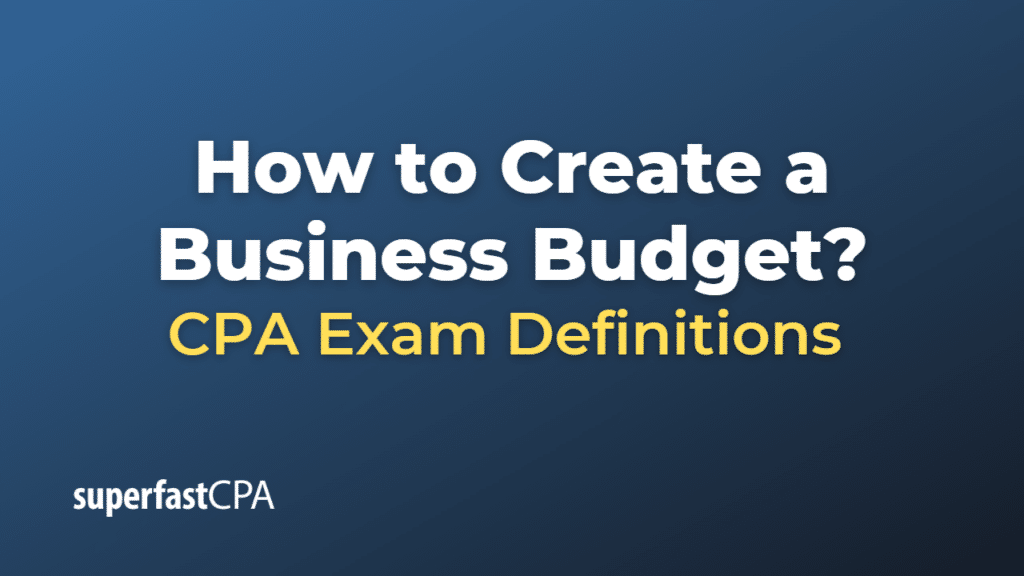How to Create a Business Budget
Creating a business budget is crucial for any size business, as it helps to predict future revenue and expenses, guides financial decisions, and measures a company’s financial health. Here’s a step-by-step guide on how to create a business budget:
- Identify Your Revenue: Start by calculating your total revenue. This includes sales, returns and allowances, interest income, and any other sources of business income. If you’re a startup, you can base this on market research and industry data.
- Determine Fixed Costs: Fixed costs are expenses that remain the same each month. This includes rent or mortgage, salaries, utilities, insurance, and depreciation/amortization.
- Determine Variable costs: Variable costs are expenses that fluctuate each month based on the level of business activity. This includes direct materials cost, direct labor cost, commissions, marketing and advertising, and travel expenses.
- Consider Semi-Variable Costs: These are costs that may not fit neatly into fixed or variable categories. For instance, your business might need to ramp up production at certain times of the year, affecting labor and supply costs.
- Predict One-Time Spends: This includes items like office furniture, computers, software, or any other major purchase that is not a regular recurring expense.
- Pull All the Information Together: Add up your costs (fixed, variable, semi-variable, and one-time expenses) and subtract them from your revenue. This will give you a comprehensive view of your budget.
- Create a Cash Flow Statement: A cash flow statement can give you a clearer picture of your business’s liquidity and ability to pay bills. It outlines where your money comes from and where it’s going.
- Review Your Budget Regularly: Once you’ve created your budget, make sure you’re sticking to it. Review your budget regularly to track actual spending versus your budgeted amounts and make adjustments as needed.
- Use Budgeting Tools: There are many budgeting software and tools available that can help you create and manage your budget effectively. They can save you time, reduce errors, and provide valuable insights.
- Plan for the Future: Use your budget to project future scenarios and make business plans. A budget can provide benchmarks that let you measure performance and make necessary adjustments.
Remember, the key to creating an effective budget is to be realistic. Don’t overestimate your revenue or underestimate your costs. Adjust your budget as necessary, and remember it’s a guide to help you manage your business finances effectively, not a hard and fast rulebook.
Example of How to Create a Business Budget
Let’s create a hypothetical annual budget for a small retail business named “John’s Gadget Store.”
- Identify Your Revenue: John estimates based on past sales and the current market trend that he’ll make $250,000 in total revenue.
- Determine Fixed Costs:
- Rent: $24,000 ($2,000 per month)
- Salaries (2 employees, $1,500 per employee per month): $36,000 ($1,500212)
- Utilities (Internet, electricity): $4,800 ($400 per month)
- Insurance: $1,200 ($100 per month)
- Determine Variable Costs:
- Cost of Goods Sold: John estimates this to be around 50% of sales, so $125,000 ($250,000*0.5)
- Credit Card Fees: Assuming an average fee of 2.5%, the estimated expense is $6,250 ($250,000*0.025)
- Consider Semi-Variable Costs:
- Marketing: John plans to spend about 2% of total revenue on marketing, so $5,000 ($250,000*0.02)
- Predict One-Time Spends:
- New POS System: John plans to upgrade his POS system, which will cost around $3,000.
By adding up all costs (fixed, variable, semi-variable, and one-time spends), John anticipates that his total costs will be $205,250 ($66,000 + $131,250 + $5,000 + $3,000).
- Pull All the Information Together: Now, let’s subtract total costs from total revenue to calculate expected net income:Expected Net Income = Total Revenue – Total Costs Expected Net Income = $250,000 – $205,250 = $44,750
So, based on this budget, John can expect to make a net income of $44,750 by the end of the year. However, he should review this budget monthly, compare the actual numbers with the budget, and adjust as necessary.
Remember, budgeting is an ongoing process and the more often it’s done, the more accurate the budget will be.













